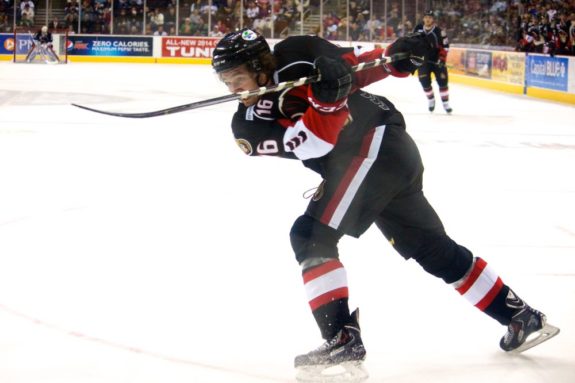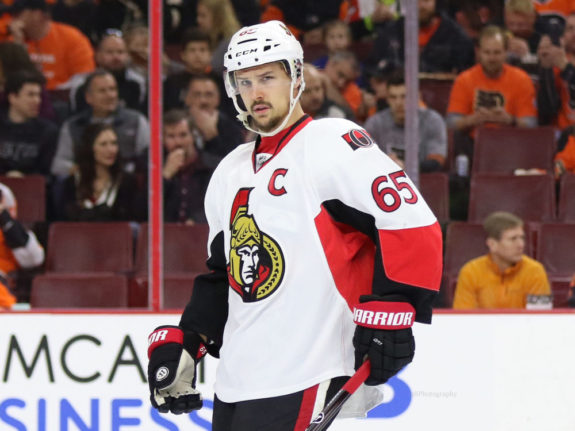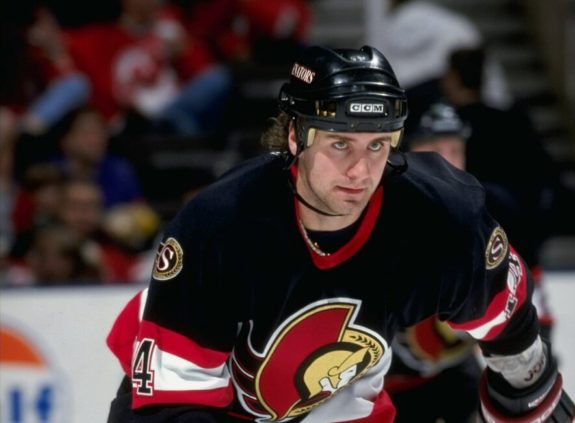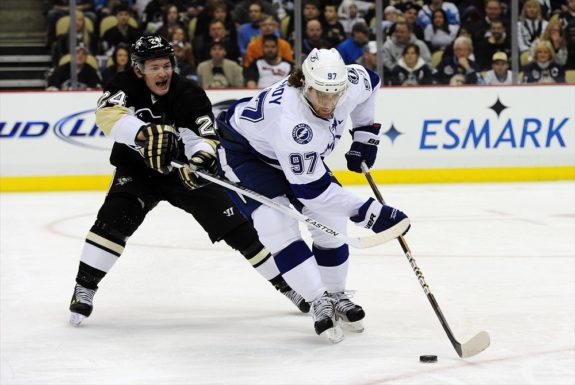
 Dayton Reimer
The Hockey Writers
Dayton Reimer
The Hockey Writers
64
Reads
0
Comments
They Wore It Once: Senators Players and Their Unique Numbers
In the early days of the NHL, a player’s number was a status symbol. The higher the number, the more important you were to the team. Goalies were given number 1, then the defence got numbers 2 to 6, and the team’s top forwards usually ranged from 7 into the low teens. Depth players would find themselves with numbers in the 20s and the backup goalie would be given 30. Numbers were more fluid and only really stuck to players who were at the top of the league.
Related: The Worst First Overall Draft Picks in NHL History
As the league expanded, both in terms of teams and the size of the rosters, the need for higher numbers became a necessity. Numbers switched from a status symbol to personal expression, with many using them to honour a favourite player, a specific year, or any other number of reasons. Jaromir Jagr famously wears 68 to commemorate the Prague Spring in the Czech Republic, as well as his grandfather, who died in prison that year.
However, some of these higher numbers are still relatively new territory, resulting in several numbers having only one name attributed to them. The Ottawa Senators, while only having 10 numbers unclaimed – one of the lowest league-wide – have 19 numbers that only one player has worn for at least one NHL game. Here is a run-down of all the players who have only worn it once for the Senators.
#50: Patrick Sieloff (2018)
Patrick Sieloff joined the Senators in 2016 in a minor deal that sent forward Alex Chiasson to the Calgary Flames. A former second-round pick in 2012, he had shown that he could be a hard-hitting defensive presence in the OHL and World Juniors, but so far only played one NHL game in his career. He got just one more chance with the Senators, playing 11 minutes and scoring a goal. He was traded to the Anaheim Ducks in another minor deal the following season for Brian Gibbons. Interestingly, he has scored in each game he has played, giving the 26-year-old a point-per-game pace in the NHL. He wore number 50 in his two appearances.
#60: Mark Stone (2012)
Most will remember Mark Stone with a 61 on the back of his sweater, but he didn’t start with that number. In the 2011-12 Playoffs, he was called up from the WHL’s Brandon Wheat Kings to play in Game 5 of the Conference Quarterfinal against the New York Rangers. He had worn number ’16’ all throughout junior, but when he arrived, he found that number was in the possession of Bobby Butler. So, instead, he opted for ’60’. In his first NHL game, he only played eight minutes on even strength, but made up for it on the power play and registered a primary assist on the first goal of the night, scored by Jason Spezza.

Stone would appear in just four games the following season, and as Butler signed with the New Jersey Devils that offseason, he grabbed his familiar ’16’, but was only called up for four games, plus another single playoff appearance. He started the 2013-14 season in the minors, not joining the team until January. However, by then, his ’16’ had already been claimed, this time by veteran Clarke MacArthur. This time, Stone went for the tried-and-true number flip, opting to wear 61. That season, he was second in Calder Trophy voting as the league’s top rookie, resulting in Stone keeping the number for the rest of his career thus far.
#62: Eric Gryba (2012-2015)
The Senators drafted Eric Gryba in the third round of the 2006 draft and after toiling in the minors for several seasons, he finally got his shot in 2012-13. While he wore number 2 with the Binghamton Senators, that was already owned by Jared Cowen, so Gryba was given 62 instead. He played well enough to remain in the NHL for the rest of the season, so when he returned to camp in 2013-14, he kept his rookie number. Over three seasons, he played 165 games and chipped in 29 points, primarily playing a defensive role. His time with the Senators ended in 2015-16 when he was shipped off to the Edmonton Oilers in order to make room for Cowen.
#63: Tyler Ennis (2020)
When Tyler Ennis joined the Senators prior to the 2019-20 season, expectations were low. He came into the league with the Buffalo Sabres in 2010-11, who selected him in the first round of the 2008 draft and he exploded with a red-hot 49-point rookie campaign. But injuries and the Sabres’ continually poor finishes limited his development and he never topped his first season totals. So, when he signed in Ottawa, he did so for just above league minimum and was expected to provide scoring depth and a veteran presence for their young roster.

Yet Ennis surprised with a 33-point season and was on pace to post his highest total and most games played since 2014-15. The rebuilding Senators shipped him to the Oilers for a 2021 fifth-round pick and he continued to produce up to the season cancellation, scoring four points in nine games. For every team he’s played for, Ennis has always worn 63, but in junior, he sported a 22, switching to an 11 in the AHL when it was unavailable. When he joined the Sabres, Adam Mair already wore 22, and 11 had been retired in honour of Gilbert Perreault. So Ennis took what he was given and now has happily carried it throughout his career.
#64: J.C. Beaudin (2019-Present)
J.C. Beaudin has had little consistency when it comes to sweater numbers. He started with 16 for the Rouyn-Noranda Huskies in the QMJHL, where the Colorado Avalanche drafted him from in 2015. When he made his professional debut with the San Antonio Rampage in 2017-18, he wore 46, then with the ECHL’s Colorado Eagles, he wore 8. The Eagles joined the AHL the following season, and Beaudin stayed with them, but his number still changed back to 46.
Related: Blues’ Best Defensemen in Team History
He was traded to the Senators in 2018-19 and his number changed twice – first 26, then 11. But when Beaudin wore 64 in his NHL debut this season, he made his mark in Senators’ history. Maybe this will be the one he finally keeps.
#65: Erik Karlsson (2009-2018)
The number 65 will likely always be attributed to Erik Karlsson, arguably the greatest defenseman to ever play for the franchise. He sits third among all Senators in both assists and points, despite being eighth in games played. The defender was selected 15th overall in 2008 to some criticism that he was too slight and not defensively skilled, but he shocked his critics when he made the team just two seasons later. By his third season, he was almost a point-per-game player from the blue line and would end up winning two Norris Trophies as the NHL’s best defender in 2011-12 and 2014-15.

But it might be interesting to note that Karlsson’s first choice of number was likely not 65. When he was drafted, he had primarily worn number 5; it’s what he wore at both the 2008 U18 tournament and 2009 World Juniors for Sweden. Yet when he joined the Swedish Hockey League’s (SHL) Frolunda HC in 2008-09, he switched to 65, which he would keep when he debuted with the Senators in 2009-10. Despite his tumultuous departure from the team in 2018-19, it’s likely he could also be the last player to wear 65 for the Senators, as he seems destined to be honoured by the team after he retires.
#67: Ben Harpur (2015-2019)
The 6-foot-6 giant began his career wearing number 7 for the Guelph Storm of the OHL, but when he made his NHL debut late in 2015-16, he’d switched his number several times already. So, when he was given 67, he must have figured it was close enough to his original number. Ben Harpur bounced between the Senators and the AHL for three seasons, with his best coming in 2018-19 when he played 51 games, scoring a goal and four assists. He left the organization the following season in a six-player deal with the Toronto Maple Leafs, which brought Connor Brown and Nikita Zaitsev to the team.
#68: Mike Hoffman (2011-2018)
Mike Hoffman had a long road to the NHL. He was passed over once before the Senators used a fifth-round pick in 2009 to select him after he helped the Drummondville Voltigeurs win a QMJHL championship. He made his AHL debut in 2010-11, but struggled in his rookie season and spent some time in the ECHL to help build his confidence. For the next three seasons, Hoffman spent the majority of his time in the AHL, while getting a couple of call-ups over the years.

Finally, in 2014-15, he made the Senators opening night roster and he became an instant success. Together with Mark Stone, the rookies drove Ottawa’s offense, both ending top-five in scoring and finishing first and second in goals. No longer would they be considered second-tier prospects; Hoffman and Stone looked like the future for the Senators. But all good things come to an end and after a controversy in 2017-18 offseason with Karlsson, Hoffman was shipped off to the Florida Panthers via the San Jose Sharks for a couple of picks, prospects, and Mikkel Boedker.
#70: Danny Taylor (2018)
One of the few British NHL players, goaltender Danny Taylor hung around the league for over a decade but played just four games over his career. His first came late in 2007-08 season the Los Angeles Kings, who started seven goalies over the season, tying a league record. His next appearances came almost exactly five seasons later with the Calgary Flames, where he’d also record his first (and only) NHL win. Another five seasons later, Taylor was with the Senators, and he played a single game for them as the 2017-18 season was winding to a close. Interestingly, he’d wear a different number each time: 46 with the Kings, 41 with the Flames, and finally 70 with the Sens.
#72: Thomas Chabot (2016-Present)
After the departure of Karlsson, Thomas Chabot has become the team’s future on the blue line. And like his predecessor, he also is the only one who has laid claim to his current number. He originally wore 5 with the QMJHL’s Saint John Sea Dogs, but when he joined the Senators in 2016-17, Cody Ceci was still wearing the number. So, he took what he was given and made it his own. In his rookie season, Chabot scored 25 points in 63 games, then exploded to a 55-point sophomore season in 2018-19.

While he took a slight step back this past season, scoring just 39 points, Chabot still promises to be the Senators’ best defenseman for years to come. He averaged 26 minutes per game in 2019-20, the highest average in the NHL, and his 186 shots were one of the highest totals among defensemen. As he continues to grow and develop, he’ll help make the Senators a force to be reckoned with.
#76: Radek Bonk (1995-1997)
There was much anticipation when Radek Bonk joined the Senators in 1994-95. One of the most highly-rated prospects in 1994, Ottawa had snagged him with the third-overall pick. He had already made headlines when he decided to play for the Las Vegas Thunder of the IHL instead of his native Czech Republic, then again when he refused to sign his entry-level deal right away, believing he could make more. The gamble failed miserably, though and he took a smaller deal when hockey resumed after the 1995 lockout.

When he joined the team in Jan. 1995, he chose to wear 76, which he had worn with the Thunder but struggled early on. General manager Pierre Gauthier reportedly disliked what he called ‘vanity numbers’ and before the 1997-98 season, he convinced Bonk to switch to a lower, more reasonable number. Bonk chose 14, and the change seemed to lift a weight off his shoulders like he finally was free from the hype and failed expectations that 76 carried with it. From 1998-99 to his trade to the Los Angeles Kings in 2004, he was one of the team’s most reliable forwards and has become one of the Senators’ forgotten stars of the 2000s.
#77: Joe Corvo (2013-2014)
Ever since Ray Bourque, defensemen have longed to wear the number 77. While Joe Corvo is no Bourque, he still made his mark as a reliable offensive defender, recording 40 points twice in his NHL career. He made his debut in 2002-03 with the Kings, but as 7 was being worn by veteran Derek Armstrong, he wore whatever he was given. It wasn’t until he joined the Senators in 2006-07 that he finally got to wear his 7 again, which he kept for two seasons when he was traded to the Carolina Hurricanes. Corvo returned in 2013-14, but this time, Kyle Turris was wearing 7, so emulated Bourque again and switched to 77.
#85: Vitali Abramov (2018-Present)
Vitali Abramov was acquired from the Columbus Blue Jackets in the Matt Duchene deal in 2019. He had an incredible QMJHL career, scoring the most points by a rookie in 2015-16 with 93, then led the league in points the following season with 104. When he made his Senators’ debut this season, it was the first time he’d ever worn a different number – in the QMJHL, AHL, and international stage, he’d always worn 11.

However, the ’11’ hangs from the rafters at the Canadian Tire Centre in honour of Daniel Alfredsson, so Abramov was given 85 instead. In his three games with the Senators so far, he has just a single goal, but will undoubtedly earn more time in coming seasons. He’s undersized but has the potential to be a high-scoring winger if he becomes more consistent in the NHL.
#86: Christian Wolanin (2017-Present)
2019-20 was a tough season for Christian Wolanin. With a depleted roster, a spot on the top-six looked to be his to lose. He was coming off a very successful 2018-19, his first professional season, where he scored 31 points in 40 AHL games. That had followed a great final season at the University of North Dakota, where he had 35 points in 40 games. But then a torn labrum took him out of the running and nearly the entire season. Wolanin returned March 7, 2020, and played three games before the season was cancelled due to the pandemic. Thankfully, it’s given him time to fully recover and prepare for his next training camp in 2020-21.
#91: Alexandre Daigle (1993-1997)
The number 91 carries with it bitterness and frustration among Senators fans. Alexandre Daigle wore the number when he joined the team in 1993-94, immediately after going first overall. He was touted as the next Gretzky after scoring 137 points with the Victoriaville Tigres and the Senators thought they had a star on their hands. However, he never scored more than 51 points in the NHL. Daigle switched to 9 in 1997-98, but the image never stuck as he was traded later that season to the Philadelphia Flyers. Nine years later, fans still hadn’t forgiven him; when Oleg Saprykin joined the team in 2006-07, he was encouraged to switch his 91 to something else. He ended up wearing 61.
#93: Mika Zibanejad (2011-2016)
Mika Zibanejad will likely go down, along with Zdeno Chara and Robin Lehner, as one of the best players to leave the Senators too soon. Ottawa surprised the crowd in St. Paul, Minnesota when they jumped for the Swedish forward sixth overall at the 2011 draft; most mock drafts slated him somewhere between the seventh and 10th picks. Even more surprising is that the power forward made his NHL debut the very next season, making the team out of camp. He would be returned to Djurgardens IF of the SHL after nine games, but he was far closer to the NHL than anyone could have guessed.

Over the next four seasons, Zibanejad steadily increased his point production, starting with 20 points in 2012-13, then following it with seasons of 33, 46, and 51 points. Already at 23, he was the team’s first-line center and getting steadily better every time he stepped on the ice. But with a big raise coming up, the Senators decided to make a business decision and flip him to the Rangers for Derick Brassard and a second-round pick. While it made sense financially, it was an awful trade in every regard – Zibanejad has become a 70-point player in his prime, while Brassard has bounced from team to team, unable to repeat his career-high of 60 points, set in 2014-15.
#94: Stanislav Neckar (1994-1997)
Stanislav Neckar was a promising young defenseman when he joined the Senators in 1994-95. A second-round draft pick the previous summer, he quickly won fans over with his hard-hitting style, earning the nickname ‘Stan the Man’. His best season came in 1995-96 when he played all 82 games and scored 12 points. However, his development was halted in 1996-97, when he missed all but five games that season. When he returned the following season, he switched his number from 94 to 24 but was still unable to return to form.
Related: Senators’ All-Time One and Done Skaters
Early in 1998-99, Neckar was traded to the Rangers for Bill Berg and a second-round draft pick, and then again to the Phoenix Coyotes for Jason Doig and a sixth-round pick before the end of the season. He began to find his groove again with the Coyotes, which made him an attractive option for the surging Tampa Bay Lightning, who acquired Neckar, along with Nikolai Khabibulin for four players and a pick in March of 2001. Just over three seasons later, Neckar would hoist the Stanley Cup with the Lightning, despite only appearing in two games with the team.
#95: Matt Duchene (2018-2019)
When Matt Duchene arrived in Ottawa, he was seen as a key piece that would push the Senators over the top and help them find playoff success. However, while he had worn number 9 during his time with the Avalanche, it was already worn by Bobby Ryan, so he simply added a number to make his it 95. Yet maybe the change messed with his rhythm, as the trade turned out to be a total disaster for the Senators. Duchene eventually asked for a trade out and was sent to the Columbus Blue Jackets after just a season and a half, while the Senators recuperated a first-round pick, using it to select promising defenseman Lassi Thomson.
#97: Matt Gilroy (2012)
The Senators acquired Matt Gilroy at the 2011-12 deadline, coming over from the Lightning in exchange for Brian Lee. Gilroy was having a career year in Tampa Bay, scoring 17 points in 53 games, but the Lightning were looking like they’d miss the playoffs after reaching the Conference Final the season prior. Ottawa was happy to part with Lee, who, after being selected ninth overall in 2005, had failed to develop into a star defenseman. Gilroy would provide depth for what the Sens hoped would be a deep playoff run. Sadly, it lasted just a single series, and Gilroy departed that offseason, signing with the Rangers.

Gilroy’s number is not a very common choice for many players, but he has a good reason for wearing it. When he was nine years old, Gilroy’s younger brother, Timmy, died after falling off his bike. On their youth hockey team, the pair wore 98 and 97, respectively, as a homage to their favourite player, Wayne Gretzky. But ever since, Gilroy has adopted his brother’s former number, wearing it on every sweater, no matter where he ends up. (from ‘Olympic dream for ex-Ranger Matt Gilroy is a Long Island-based family affair,’ New York Daily News, 02/18/2018)
Who’s Next?
As mentioned before, the Senators have just 10 numbers still unclaimed: 66, 69, 75, 80, 84, 87, 88, 92, 96, and 98. While no one has worn number 8, it was retired before anyone could step on the ice for the Sens. It honours Frank Finnigan and the original franchise, which lasted from 1884-1934. And, of course, no one has worn 99, but after Wayne Gretzky, who would want to?
With much already having been said about the talent available at the 2020 NHL Draft, it begs the question if any of the highly-touted prospects the Senators select will opt for a fresh number with no history, giving them the freedom to carve out their own history with the franchise. Or maybe they choose to give new life to an underrepresented number, based on a personal connection.
That is, as long as it’s not 91.
The post They Wore It Once: Senators Players and Their Unique Numbers appeared first on The Hockey Writers.
Popular Articles

















































 Blackhawks Chicago
Blackhawks Chicago Panthers Florida
Panthers Florida Penguins Pittsburgh
Penguins Pittsburgh Rangers New York
Rangers New York Avalanche Colorado
Avalanche Colorado Kings Los Angeles
Kings Los Angeles Maple Leafs Toronto
Maple Leafs Toronto Bruins Boston
Bruins Boston Capitals Washington
Capitals Washington Flames Calgary
Flames Calgary Oilers Edmonton
Oilers Edmonton Golden Knights Vegas
Golden Knights Vegas Senators Ottawa
Senators Ottawa Lightning Tampa Bay
Lightning Tampa Bay Flyers Philadelphia
Flyers Philadelphia Red Wings Detroit
Red Wings Detroit Islanders New York
Islanders New York Sabres Buffalo
Sabres Buffalo Devils New Jersey
Devils New Jersey Hurricanes Carolina
Hurricanes Carolina Blue Jackets Columbus
Blue Jackets Columbus Predators Nashville
Predators Nashville Stars Dallas
Stars Dallas Jets Winnipeg
Jets Winnipeg Wild Minnesota
Wild Minnesota Blues St. Louis
Blues St. Louis Mammoth Utah
Mammoth Utah Ducks Anaheim
Ducks Anaheim Canucks Vancouver
Canucks Vancouver Sharks San Jose
Sharks San Jose






